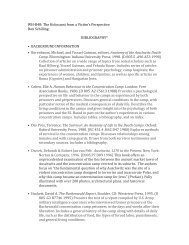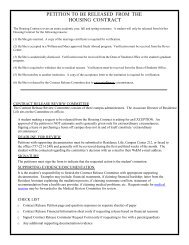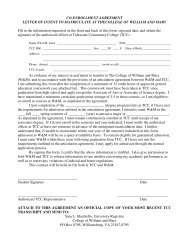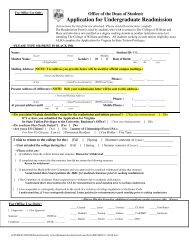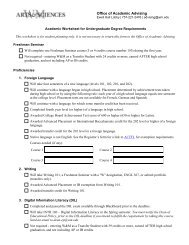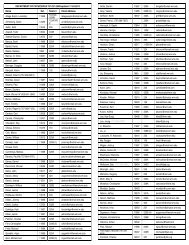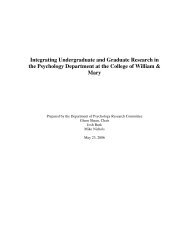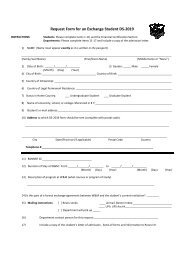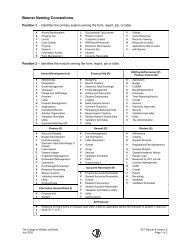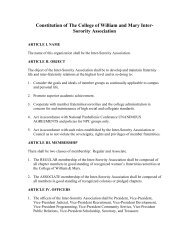Course Selection Guidebook [pdf] - College of William and Mary
Course Selection Guidebook [pdf] - College of William and Mary
Course Selection Guidebook [pdf] - College of William and Mary
You also want an ePaper? Increase the reach of your titles
YUMPU automatically turns print PDFs into web optimized ePapers that Google loves.
<strong>Course</strong> <strong>Selection</strong> <strong>Guidebook</strong> – Fall 2011101-102. General Physics - (Physics 101 is a prerequisite for Physics 102. Only Physics 102satisfies GER 2A) Fall-Spring (4,4) Co-Requisite: 101L <strong>and</strong> 101P or 102L <strong>and</strong> 102P. Concurrentregistration in or prior completion <strong>of</strong> Mathematics 111-112 is recommended. Topics emphasizedinclude Newton’s law <strong>of</strong> classical mechanics, the laws <strong>of</strong> electricity <strong>and</strong> magnetism, <strong>and</strong> somemodern physics including applications. Three lectures (approximately 100 students), onediscussion hour (25 students), <strong>and</strong> laboratory (20 students) per week. (Students may not obtaincredit for both Physics 101 <strong>and</strong> 107, or for both 102 <strong>and</strong> 108.)105. Great Ideas in Physics - (GER 2A) Fall (3) An introduction to the fundamental laws <strong>and</strong>dominant themes <strong>of</strong> modern physics, illustrated with selections from the classics <strong>of</strong> sciencewriting. The course is intellectually sophisticated, but requires no mathematics beyond ratios. (Notappropriate for science <strong>and</strong> Mathematics majors.) (Students may not receive credit for Physics 105if taken after passing Physics 101 or 107.)107-108. Physics for the Life Sciences - (Physics 107 is a prerequisite for Physics 108. OnlyPhysics 108 satisfies GER 2A) Fall <strong>and</strong> Spring (4,4) Co-Requisite: 107L <strong>and</strong> 107P or 108L <strong>and</strong>108P. The course covers the fundamental concepts <strong>of</strong> Physics. In two semesters Newtonianmechanics, wave motion, electrical <strong>and</strong> magnetic fields, simple circuits, <strong>and</strong> some modern physicsare discussed. It is designed for students in the life sciences, including pre-meds. High schoolscience, as well as algebra <strong>and</strong> trigonometry, are assumed. (Students may not obtain credit for bothPhysics 101 <strong>and</strong> 107, or for both 102 <strong>and</strong> 108.)109-110. Practical Physics - (GER 2A) Spring (3,1) Concurrent enrollment in Physics 110 isstrongly encouraged. Everyday devices like bicycles, guitars, <strong>and</strong> cameras are explained asillustrations <strong>of</strong> the underlying laws <strong>of</strong> mechanics, acoustics, optics, thermodynamics, <strong>and</strong>electromagnetism. Mathematics is limited to algebra. (Students may not receive credit for Physics109 if taken after passing Physics 101 or Physics 107.)121. Physics <strong>of</strong> Music - (GER 2A) Fall (3) The physical principles needed to underst<strong>and</strong> theproperties <strong>of</strong> sound <strong>and</strong> music. Three lectures (25 students) per week.150W. Freshman Seminar - Fall (4) See separate listing <strong>of</strong> course(s) available.176. Introductory Astronomy - (GER 2A) Fall <strong>and</strong> Spring (3) The physics <strong>of</strong> the solar system,stars, galaxies, <strong>and</strong> the universe as a whole. Three lectures (100 students).177. Astronomy Laboratory – Fall (1) Pre- or Co-requisite Physics 176. Experimental techniques<strong>of</strong> astronomical observation.PsychologyThe wide range <strong>of</strong> courses <strong>of</strong>fered by the Psychology Department reflects the diversity <strong>of</strong> thediscipline. <strong>Course</strong> <strong>of</strong>ferings can be categorized according to two major themes: either natural orsocial science. While Psychology courses <strong>of</strong>fered from a natural science perspective provide anunderst<strong>and</strong>ing <strong>of</strong> perception, cognition, learning, <strong>and</strong> the biological bases <strong>of</strong> behavior, those from asocial science perspective focus on development, personality, social processes <strong>and</strong> abnormalbehavior .Classes cover topics as diverse as neuropsychology, development from infancy throughadolescence, people in a social context, <strong>and</strong> dealing with maladaptive behaviors.70


![Course Selection Guidebook [pdf] - College of William and Mary](https://img.yumpu.com/46952524/70/500x640/course-selection-guidebook-pdf-college-of-william-and-mary.jpg)
